It’s been more than a year since I last worked on this series! In the meantime, Nier Replicant ver.1.22474487139… has been released, the YoRHa: Dark Apocalypse raid series has drawn to a suitably confusing conclusion, and in Japan, players have got their hands on dubious gacha spinoff NieR Reincarnation! All very exciting for the kind of someone who writes a series like this, and once I’ve finished the new version of Replicant, I will go ahead and update the previous article. But for now, let’s keep our focus on the bridge between Replicant/Gestalt and Automata…
Inevitably, this will contain major spoilers for NieR: Automata.
Contents
Contents
- Another quick recap
- Sources
- Picking up what few pieces remain: the timeline resumes
- The Space War (NieR Replicant Drama CD) (translation)
- War Is Beginning (timeline)
- The Fire of Prometheus
- The machines experiment with living
- The androids experiment with dying: Project YoRHa concert drama
- Paranoia priorities: A Much Too Silent Sea
- The Pearl Harbour descent: YoRHa gets traumatised for the first time
- Equal opportunity evil experiments: the M002 unit
- Introducing our heroes
- Meanwhile, among the Machines…
- Our Devolapopola
- The 243rd Descent Operation
Another quick recap
How it all ends
In 2003, an unexpected incursion of magical creatures from another timeline creates a plague that threatens to wipe out humanity, in the form of the maso, the demonic element. The powers that be—acting through the ‘Hamelin Organisation’—resort to a desperate plan to preserve some small portion of humans: separating their souls, or ‘gestalts’, from their bodies, and then creating ‘replicant’ bodies from these gestalts, who are immune to the corrupting power of maso. In this form, the humans can wait out the apocalypse, while androids and replicants purge the world of maso. So far so… straightforward? Hmm, I may have lost calibration there.
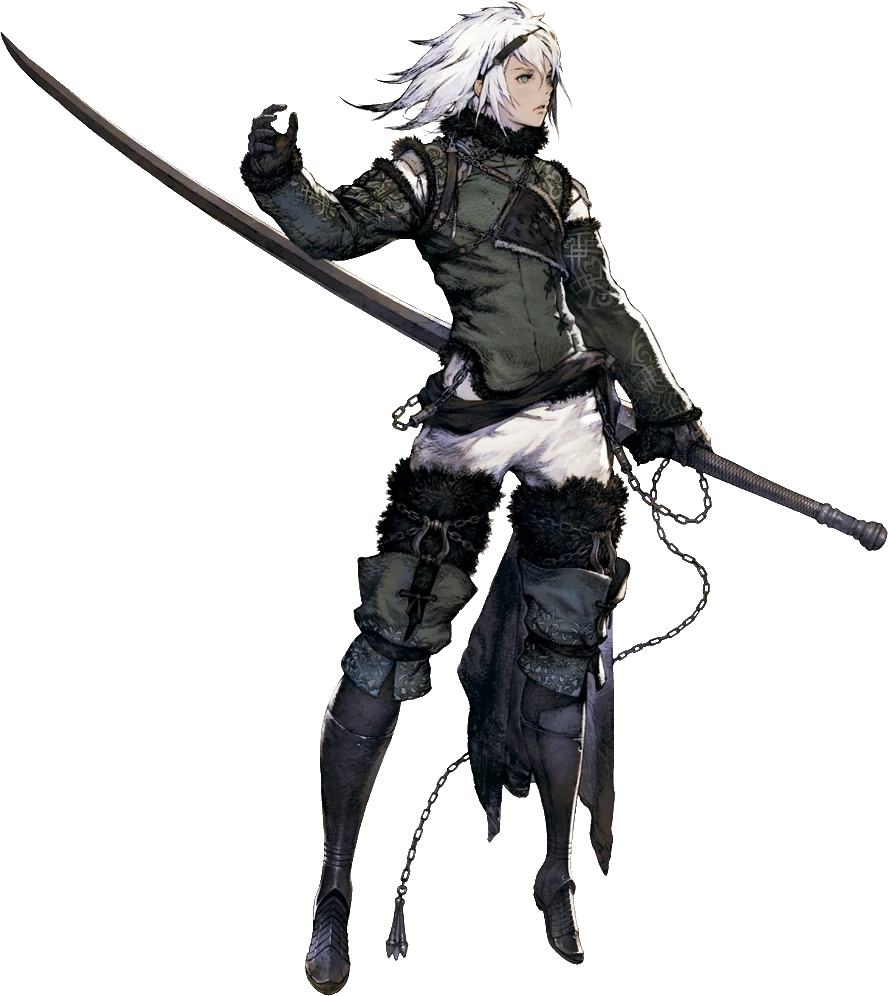
Their plan almost fails, because the gestalts prove to be terribly unstable, prone to ‘relapse’ that causes them to decay to a berserk, mindless state and infects their corresponding replicant with a disease dubbed the ‘Black Scrawl’. The only way they can be preserved is the special ‘stable’ maso produced by a boy or man (depending on edition) named Nier, who is discovered by a disingenuous scheme to hand out copies of a magic book to war refugees that will forcibly gestaltise its holder.
Unfortunately, Nier’s sister/daughter Yonah is not nearly so lucky as him; when she touches her copy of the book, her gestalt almost immediately relapses. The Hamelin Organisation, desperate to control the one person who can hold up their survival plan, promise they will save Yonah if Nier provides stable maso for a thousand years. Of course, they are lying, and have no way to save her.
Over that time, the plan suffers another hiccup. The replicants, supposed to be mindless vessels, start developing minds of their own and forming societies. When the time comes, they resist attempts to reunite them with gestalts, perceiving the gestalts as monsters they term ‘shades’. Some gestalts begin to realapse, becoming monsters in truth.
The gestalts, along with the android overseers of the project such as Devola and Popola, panic; their only solution is to use the two magic book devices, Grimoire Noir and Grimoire Weiss, to forcibly return every gestalt into their replicant bodies at once, effectively genociding the replicants to save the gestalts. However, this plan requires Weiss to be powered up by collecting things called ‘sealed verses’. Dev and Pop hatch a scheme to trick Replicant Nier, who lives a hard life trying to find money to support his Yonah, into acquiring the sealed verses.
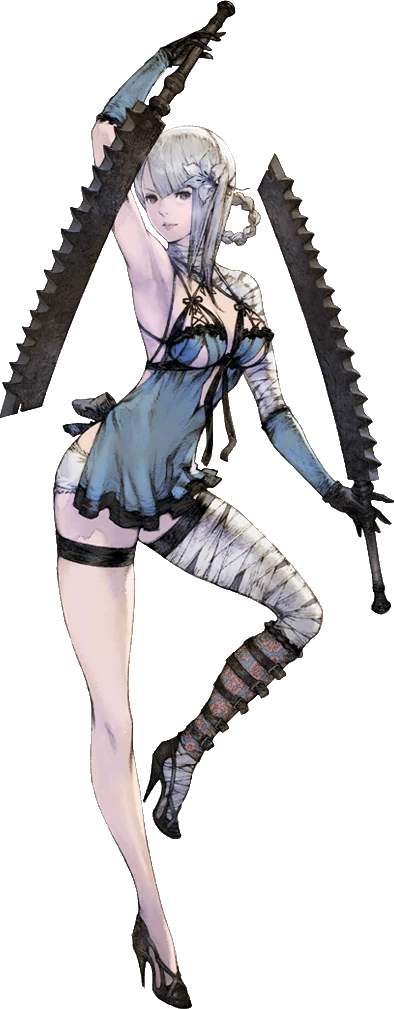
Over the course of this quest, Nier encounters various societies: notably the masked city of Façade. He becomes close friends with two outcasts: Kainé, ostracised both for her intersex status and the sociopathic Shade possessing half her body; and Emil, an immortal experimental weapon from before the apocalypse who lives on top of the lab which manufactured him and his sister.
Meanwhile, Gestalt Nier—who has adopted the edgy moniker of ‘Shadowlord’—finally catches on that they’re tricking him, and resolves to take matters into his own hands to save Yonah. He attacks the village where Replicant Nier lives along with some loyal Gestalts, attempting to seize control over Grimoire Weiss. But Grimoire Weiss has grown so close to Nier, Emil and Kainé that he resists control; Gestalt Nier resorts to flying off with Replicant Yonah so he can at least restore her gestalt to her body.
Desperate to recover Yonah, Replicant Nier continues to fight, becoming far stronger than Devola and Popola can control any longer. He passes through a number of tragic stories, killing shades without recognising their nature—notably for today’s story, Emil absorbs his sister Halua’s powers (to save Kainé), in the process turning into a skeleton with a huge spherical head; and the gang kill an unusually strong P-33 robot called ‘Beepy’ or ‘P-chan’ which cares for a gestalt child.

Eventually Replicant Nier makes it to the castle of Gestalt Nier, and—supported by the people of Façade—fights his way up to the top, where he is confronted by Devola and Popola, who reveal their true nature—and the trauma of working the gestalt program through the centuries. Nier kills Popola, and Devola goes berserk; to save his friends from their magic, Emil unleashes a destructive spell that appears to kill him, but his head is actually flung far away.
Replicant Nier confronts Gestalt Nier alongside Kainé and a failing Weiss, and is victorious. Gestalt Yonah chooses to leave the body of Replicant Yonah and die alongside Gestalt Nier. But the joy of victory will be short-lived: the shade inside Kainé, named Tyrann, starts to take over her body. To save her, Nier may choose to submit to a magic ritual which will erase him from everyone’s memories (in gameplay terms, deleting the player’s save file).
But regardless of his choice, the death of Gestalt Nier means all the surviving gestalts are doomed to eventual relapse. Their replicants will catch the Black Scrawl and die, and the rest will gradually die out too, lacking any independent ability to reproduce (reproduction being traditionally handled by androids recreating a replicant from a gestalt), so they will die too. Before too long, all of humanity will die out except for Emil.
So everyone will die. Is that the end of the story? Not remotely!
Sources
Initially, all we had was the Ark: some NieR fans have put together a very helpful resource at theark.wiki collecting various translations of Automata side materials. For the stage plays, Rekka has written summaries on her blog, and there are Youtube uploads with fansubs floating around—though they tend to get taken down, so I will also link torrents in case my links die.
Later, Square Enix released a translation of the short story collection A Short Story as Short Story Long. The translation is readable, but clunky, and adopts different terminology from the game’s localisation (e.g. ‘Living Machines’ rather than ‘Machine Lifeforms’), so it’s kind of a desultory effort. I will be linking fan translations since they’re about as good for the most part.
Picking up what few pieces remain: the timeline resumes
The NieR Automata Strategy Guide presents a timeline of the period leading up to Automata, which has been helpfully translated by an anonymous 4chan user and archived on the Ark wiki.
By 3631, the androids, as the only survivors of humanity, organise under a government termed the Human Heritage Reclamation Management Organisation (bit of a mouthful!), which tasks itself with preserving the remnants of the Old World. The gestalts gradually die out through this time, with the last making it more than 500 years to 4198. The androids start to give up, closing factories; a faction develops within them termed the ‘Independists’ who have no loyal to humanity, and emigrate to Australia after a brief struggle. So far, much as you’d expect.
Project Gestalt Report 11
The last Project Gestalt report in Automata discusses the collapse of the project:
December 31, 3361
[Summary]
Due to the relapse of the Original, Gestalt units in preservation are now relapsing at an accelerated rate. The process of recording their bodies and gathering their DNA continues, but progress is poor.
New countermeasures and development intended to serve as a replacement to Project Gestalt are scheduled to be transferred to the Next Generation Preservation Project Preparation Committee. As for this report, it will serve as a collected record of both Project Gestalt and the Committee. For information about the development plans for new android models and the refinement of existing models, please refer to the attached sheet.
Furthermore, we have received approval to consider the disposal of the “Devola” and “Popola” observer models at a later date.
Devolapopola
So what exactly is the disposal of the Devola and Popola models? Although the specific Devola and Popola from Nier’s village were destroyed by Emil in the battle at the Shadowlord’s castle, there are other Devolas and Popolas overseeing different regions of Replicants across the world.
In the wake of the collapse of the Gestalt System, they were collectively assigned the blame for wiping out humanity. Near the end of Automata Pod 153 lays it out explicitly to 9S:
The failure to manage the area… resulted in the collapse of the Gestalt System, which led to the decimation of the human race. Due to the discovery of its instability, the Twin System was removed from future android production designs.
Following the incident, the Devola and Popola models were not dismantled. However, in order to prevent unexpected behavior, they underwent a memory wipe. Furthermore, they were reprogrammed to generate constant feelings of guilt.
Just before this, you get the opportunity to delve into one particular Devola and Popola pair’s memories:
The story sees them struggling to cross a desert, from Popola’s point of view. Her Devola is damaged, and she does her best to care for her. Flashbacks show the breakdown of Project Gestalt: the gestalts, gradually relapsing without Nier’s stabilising maso, cause the replicants to suffer the Black Scrawl at an ever increasing rate.
And even before that, she reflects on the trauma of seeing generations of Replicants die of the Black Scrawl.
Did the humans see this coming? Is that why they made a twin model?
Were they really so clever? …Were they really so cruel?
I couldn’t have done this by myself. I would have descended into madness.
I simply couldn’t bear such a burden all alone.
Many thousands of years after the collapse of the Gestalt System, Devolas and Popolas are still shunned by the other androids, and still carry the guilt of their unknown crime.
Dev and Pops were also the ones who sent the Replicant data to the moon:
With the original Gestalt lost, humanity was doomed to an inevitable extinction.
Knowing this, we gathered what remaining Replicant data we could find and launched it ot the surface of the moon.
And though success was as unlikely as finding a lost sand grain in the desert, we still had to attempt it. We still had to try.
We were androids, you see. Protecting humanity was our instinct.
For a long time, Devola and Popola are persecuted by the other androids. We see this Devola’s leg get smashed after she talks back to another android, and Popola is ready to attack, but she backs down when Devola smiles to her. They flee across the desert, their bodies steadily breaking down.
And that would be that: a steady decay, or perhaps the androids creating something new in the ruins of humanity. But then the aliens show up!
The Space War (NieR Replicant Drama CD) (translation)
NieR Automata, you may have heard, concerns a war between humans and aliens. Yet so far there have been no aliens whatsoever! In 5012, they finally make their appearance.

A dead alien, as seen in Automata.
The story comes, as is now traditional I guess, as a kind of joke track in the Drama CD. You can listen to it on Youtube here, and read Rekka Alexiel’s translation alongside here. (The remainder of the tracks on the Drama CD comprise a non-canon high school AU, translated here.)
In brief, Emil—who has now developed a substantial robotic body—accidentally gets in a fracas with a group of wild animals, including a boar, only to be interrupted by an ‘Adamski-style’ UFO manifesting (referring to the 1952 UFO hoax by George Adamski—think of the classic ‘flying saucer’ design). The UFO opens fire on the animals around Emil, infuriating him:
Not a single one of you may move from there! I will never let anyone through who tries to hurt others!
Determined to protect “Nier, Weiss and Kainé’s planet”, Emil returns fire using his various magic attacks, but more UFOs start to arrive. To fight them, Emil uses an ability he dubs ‘Emil copy’, creating a large group of clones. Although most of them apparently merge back in at the end of the fight, we’ll see by the time of Automata that he has created many, many, many more copies.
War Is Beginning (timeline)
Despite the efforts of the ‘Emil Corps’, the aliens continue their attack. The androids finally have a purpose again, and within a year step up production of ‘combat model androids’, creating an ‘Army of Humanity’—at first a loose communications network, but it gradually develops into a unified military command.
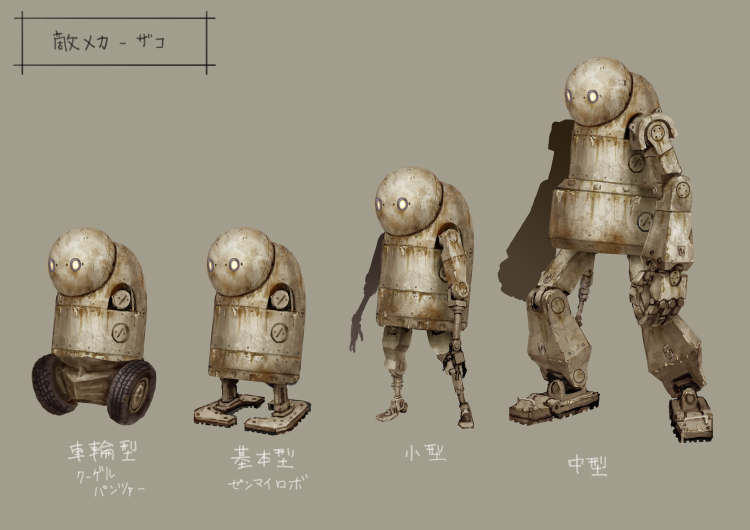
One of Hisayoshi Kijima’s concept sketches for the Machine Lifeforms.
(source)The aliens make grounds in the Americas, which are in the dark part of the tidally locked planet (the Kingdom of Night). Here, the aliens begin manufacturing ‘Machine Lifeforms’ (機械生命体) as a weapon against the androids in 5024. The androids rapidly lose ground against these new enemies, but manage to create an outpost on the moon, where they store records of humanity as it used to be. Here, they begin constructing various military bases.
By 5204 a pattern is established: the Army of Humanity possesses 12 satellite bases, from which they launch ‘descent operations’ to attempt to take back the Earth. These, by and large, fail, leaving a scattered collection of android survivors fighting guerilla wars against the Machine-held Earth.

In 6230 the Army of Humanity deploys a new weapon, termed ‘Dragon’. This entry prompted a great deal of fan speculation about whether these ‘Dragons’ are precisely the dragons in Drakengard… which was unexpectedly later confirmed by Yoko Taro in an interview. So we have at last come full circle to the beginning of Drakengard 3. Though exactly what circumstances led to the Cathedral City getting transported into the DoD world, or the reasons for the creation of the Flower… all that remains unknown!
From then on the war progresses as a deadlock. Until the incident in 7645.
The Fire of Prometheus

This story was originally published in Drag-on Dragoon INSIDE WORLD, then later republished in A Short Story. I know of three translations: the official one in Short Story Long by Shota Okui; what is probably the most idiomatic one, by Kho-Dazat; and Rekka’s translation of the first five parts (archive link since she’s taken it down on her site). The original story renders the robot phrases in katakana, which is variously translated with e.g. ALL-CAPS-WITH-DASHES or leetspeak.
The story concerns Beepy, or P-chan, the P-33 combat robot who befriended a young shade named Kalil in the Replicant/Gestalt. Per the timeline, it takes place in 7645. Despite their clunky outward appearance, Beepy has a sophisticated set of self-repair machinery in the form of tiny robotic ‘ants’ who gradually restore their functionality over thousands of hours after the battle with Nier.
Beepy has lost most of their memory, but they discover a powerful, overriding ‘will’ to ‘go see the outside world’. But the world does not cooperate, and Beepy falls through the floor back into the depths of the Junk Heap. To escape, they resort to modifying their body, becoming something like a ‘giant mechanical arachnid’ covered in arms and wheels.
Now unshackled from limitations of form, Beepy starts sweeping up more and more of the tech inside the abandoned Junk Heap—notably ‘thought and memory’ circuits which allow them to formulate more complex plans. Four ordinary P-33s attack them, but Beepy is now on another level, and easily outsmarts the robots. But rather than destroy them, or take control, Beepy has another idea: let’s awaken them to subjectivity!
It would be simple to hack into them and put a stop to their attacks that way. But I didn’t want to do that. I felt it would put me on the same level, that of a tool. Their orders did not reflect their will. A will is a joyous thing one cultivates on one’s own.
To promote such a ‘will’, Beepy bombards the four robots with the phrase ‘let us live’ through the repair ants.
Let us live. Let us discover what it is to live. I will teach you what he taught me.
The gambit works—seems like P-33s are just raring to awaken to sapience! Gradually Beepy ascends, awakening and assimilating more robots as they go, becoming a 20-metre sphere, then 50 metres. In this form, they blast their way out the top of the mountain, and observe the androids and Machine Lifeforms battling. For some reason, Khoda’s translation omits the description of the androids, so here is Shota Okui’s take:
The other faction was composed of humanoid warriors.
The majority of them were infantry. Their design was familiar—which meant that their origins were similar to ours. At first blush they appeared to be human, but upon further inspection they were extremely underdressed, almost naked, which eliminated any possibility that they were humans. No human would go to war naked in a blizzard like this. My integrated consciousness speculated that they were androids.
Women—all of the androids were female types. They were probably communicating with light waves or something similar, because they were fighting without emitting sound or radio waves. I couldn’t figure out why they were fighting the catfish.
Beepy starts receiving fire, and realises to their horror that, just like them, the androids and machines are compelled to fight by their orders and programming. Well, there’s only one thing to do in that situation! They set about granting both sides self-awareness, through the same encouragement to ‘let us live’. This contact leads to a ceasefire, a spread of ‘affectionate transmissions’ and a salute declaring the end of the war. The machines start to form a network, with individuality still possible within the collective mind, as the whole Beepy-sphere rises into space.
The story ends in a prayer of celebration, for which I have two slightly different versions:
The machines' song
We are headed ever further into the outside world, just as we promised you. We are alive, just as you were. We are singing, singing, singing. Will our song reach you? Will our feelings reach you, wherever you are? Hallelujah. Hallelujah. Hallelujah. Hallelujah.
Hallelujah!
From the machine entrusted with a humble wish, a simple hymn spreads throughout the universe.
and Shota Okui’s
We are making our way outside.
To hold our promise to you.
We are alive.
Just like you.We sing. We sing. We sing.
Will it reach you?
Will these feelings reach you?Hallelujah. Hallelujah. Hallelujah. Hallelujah.
Hallelujah.
From the wistful Machines,
their song and only their song,
resounds throughout space.
This is, I believe, the origin of the Machine Lifeforms’ ‘network’. It’s acknowledged in Automata, in one of the short picture book sections titled Spirit of Fire: by the time of Automata, the Machines seem to have taken to viewing Beepy as a god who erupted from a volcano to grant them consciousness:
One, long ago, a volcano erupted.
From the fires of eruption, a god emerged.
One day, the god appeared before the machines and said:
“Consciousness, pain, joy, misery, fury, shame, desolation, the meaning of life.”
While the main sphere of Beepy seems to have departed into space, we can presume this network lived on, gradually growing to subsume all the Machine Lifeforms. At this point, their war against the androids becomes much less furious: they hold about 80% of Earth, and resist attempts to seize it, but do not take the remainder of the planet. The war enters a stalemate, with the androids launching regular descent operations that founder against the machines.
The machines experiment with living
Eventually, the newly awakened Machine Lifeforms turn on their creators. The androids are unaware of this until the confrontation with Adam during NieR Automata. But per the timeline, the machine rebellion takes place in the 11000s, and the aliens are extinct as of 11306, a few hundred years before Automata.
Ah, but! After I first wrote this article, the destruction of the aliens by the machine lifeforms was depicted obliquely in the ‘music video’ for Antinomy by Amazarashi, the ending song for the first cour of the NieR Automata ver 1.1a anime, which in true Yoko Taro style is a ten-minute long puppet show with the actual song only playing over a looping credits sequence at the end.

Another Hisayoshi Kijima concept sketch for the Machine Lifeforms.
(source)What were the machines up to in the meantime? Per the Machine Research Report, penned by the android Jackass and released to the player only after completing Route C/D/E of Automata, they were attempting to reconcile the simple command given by the aliens as a raison d’etre with their own ongoing existence:
At this point, machine lifeforms recognized that the goal of “defeating the enemy” actually REQUIRED an enemy. In order to maintain this singular objective, they reached the contradictory conclusion that their current enemies—the androids—could not be annihilated completely, lest they no longer have an enemy to defeat.
In order to resolve this inherent contradiction, the machine lifeforms began to intentionally cause deficiencies in their network, diversifying the vectors of evolution for all machines. This is the cause behind some of the more “special” machine lifeforms, such as Pascal and the Forest King.
These ‘special’ machine lifeforms created a variety of experimental societies, but as 9S discovers while connected to the machines’ network in Route B, all of them were sterile imitations:
In the politics category are records of the machines’ own governmental endeavours.
They’d tried all sorts of things.
Absolute monarchies.
Republics.
Democracies.And that wasn’t all. They also engaged in other scholarly pursuits such as philosophy, mathematics, science and social criticsm.
It’s like the network was copying every possible human behaviour.
Almost as if…The machines are… imitating humans?
I dive deeper into the records…
I can find no indication of the machines creating new culture or values.
They only imitate human behaviour.The strange thing is, if a unit fails, it fails in the exact same way the next time.
For example, if a machine forms a dictatorship that eventually collapses, it won’t try a new type of government—it just forms a new dictatorship.
Or if it plants crops and they die, it just tries the same thing again.
And again. And again. And again.They keep performing the same behaviours. They don’t ever LEARN.
9S contrasts this with their immense adaptivity in combat. He speculates that their failure is itself the objective.
Let’s return to Jackass’s report. The machines take in records of Project Gestalt, and Nier himself.
Meanwhile, the deficient network began repeating the process of self-repair while incorporating surrounding information, until it finally reached a fixed state as a new form of network. Traces of information regarding human memories from the quantum server of the old model were discovered, indicating that it had integrated them during the final stages of its growth process. Said server contained a record of the discarded “Project Gestalt,” as well as information on the human who was the first successful example of the Gestalt process.
Having acquired information regarding humanity, the network’s structure changed once more, becoming what might better be called a meta network (or a “concept”, to borrow the words of the machines). This led directly to the formation of the ego we identify as N2.

N2, also known as the ‘Red Girls’, is the personification of the Machine Network. She displays a sadistic streak, and her design is heavily reminiscent of Manah from DoD 1—especialily when she goes into creepy grin/deep voice mode. However, not all the machines are loyal to N2, and their various experimental offshoot societies sometimes make peace with the androids.
To briefly go over some of the machine societies, in the game we witness…
- a rule-bound society that models itself after Façade in the desert area (hostile in the main game, but a peaceful faction may be encountered in the DLC)
- a monarchic, warlike forest faction organised founded in 11689 by a heroic machine named Ernst. They currently defend a baby machine named Immanuel, unable to realise Immanuel will never grow up.
- a non-hostile faction develops in the amusement park, dressing in clown makeup and shooting balloons instead of bullets (unless attacked). Later, these decay and become hostile zombies. At the centre of this area lives Simone, though she seems unlikely to be aleader.
- a machine named Pascal founds a pacifist village in another part of the forest.
- a religious faction led by one Kierkegaard takes on Catholic garb, only to very suddenly become a death cult attempting mass suicide and attacking intruders.
- some kind of military headquarters run as a rather miserable office, which appears in the DLC in which we play as Plato 1728.
- many machines take the form of fish, with corresponding machine versions of a lot of the fish that can be caught in the game.
I’ll return to these various machines later; for now, take them to illustrate the machine society possibility space.
The timeline additionally mentions:
- a large floating machine city called Atlantis, which briefly surfaces in 11502.
What’s up with their names? All the main machine lifeform characters in Automata, with the exception of Adam, Eve, and N2, are named after philosophers (mostly from European traditions, but a few Chinese philosophers appear late on). How much you should read into the specific name assignments is a matter of interpretation.
A few of these machines crop up at specific points in the timeline:
Grün
‘Grün’ is one of the largest superweapon machine lifeforms in the form of a semi-humanoid, flexible aquatic giant. He is the subject of the picture book In The Deep Sea:
The child held sway over enormous strength.
But sadly, he was also a little bit broken.
He spent his long days hurting those around him.
He tried his best to be good and kind.
But despite his efforts, things never seemed to turn out.
They told him he was unwanted.
They abandoned him in the deep, dark ocean.
And from the cold at the bottom of the sea,
He cried out:
Mother! Mother! Mother! …Mother…
But his voice never reached his mother.
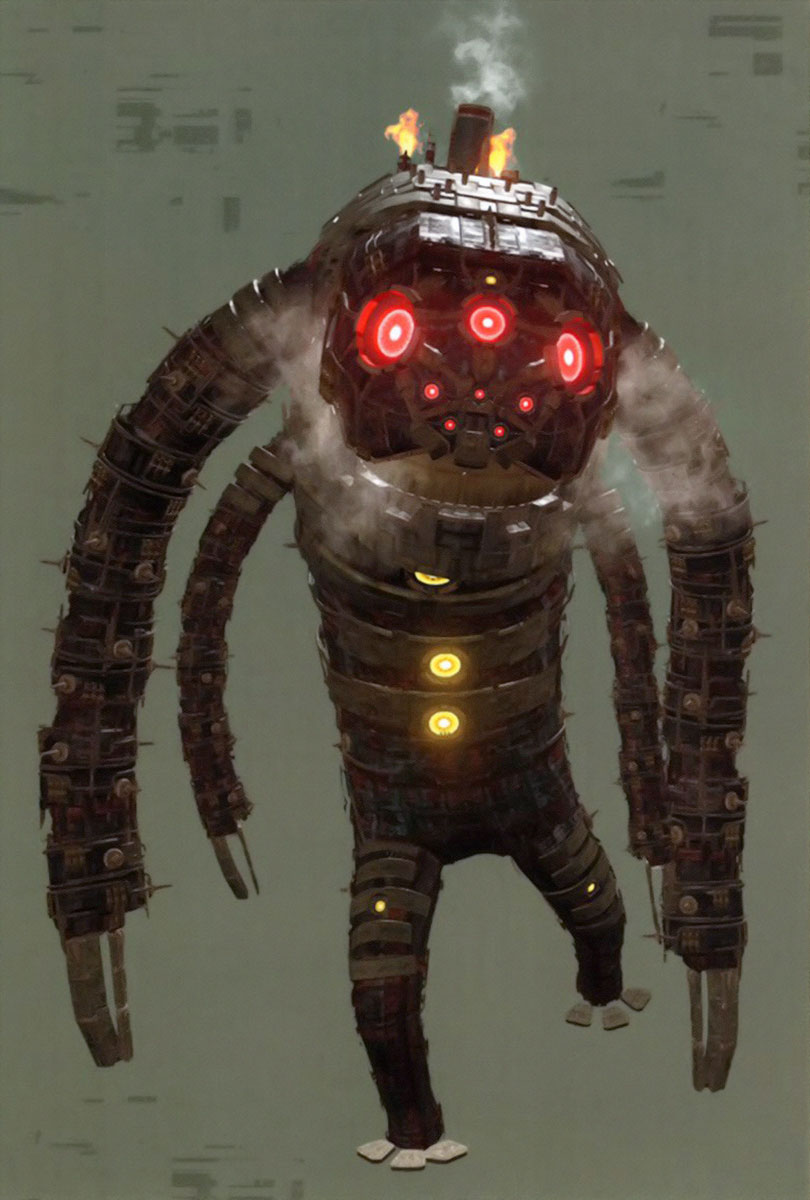
The unit description gives a more explicit account:
A machine lifeform of extreme size that was developed specifically to annihilate androids. however, due to its tendency to also destroy its fellow machines, it was eventually discarded into the sea. The part that was initially thought to be its entire body turned out to be merely its head, causing this colossus to reach over 1,000 meters into the sky when standing.
Per the timeline, Grün (the ‘Behemoth-class’ machine lifeform) was first sighted in 11627 (about 300 years before the game), and launched a devastating attack on the androids, only to disappear into the Izu-Ogasawara Trench a month later.
Grün is apparently most likely named after obscure socialist Karl Theodor Ferdinand Grün, who clashed with the young Marx in the Young Hegelians, making him one of the most obscure philosopher allusions.
Immanuel, Ernst and the Forest Kingdom
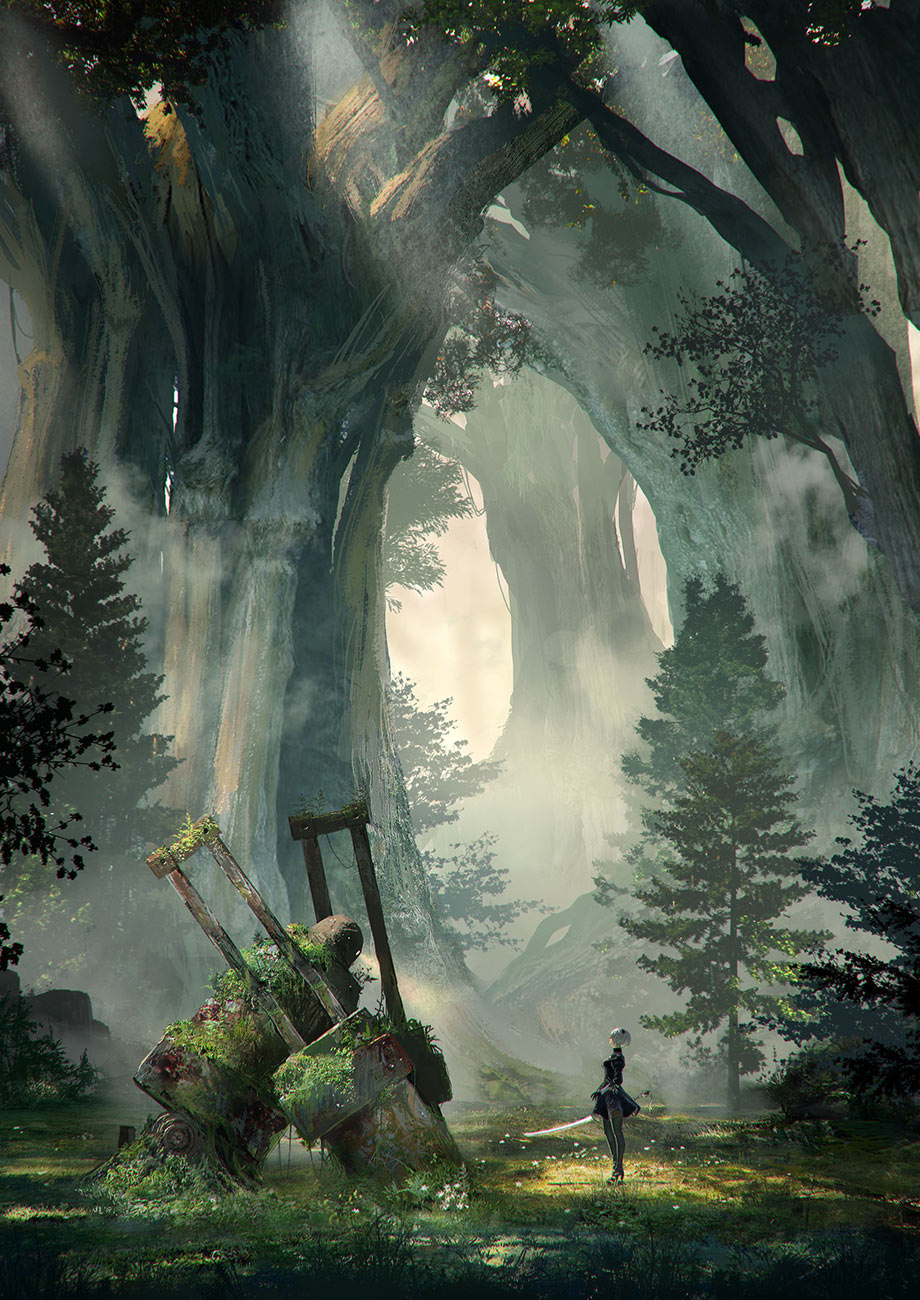
In 11689, a group of machines led by a large one named Ernst (likely after the Marxist Ernst Bloch) found a pseudo-medieval society, centred on a ruined but carefully preserved castle bordering Pascal’s village. A record of its founding myth can be found in the Letter to the Forest King. By the time of Automata, Ernst has died (in 11817), and this kingdom has become fanatical, defending a baby machine called Immanuel (after Immanuel Kant), yet unable to discern why he will not grow. Immanuel speaks his first words 120 years later in 11937, but remains baby sized.
A peaceful subfaction obsessed with fight training may be encountered in the DLC.
As far as their namesakes go, Kant was born hundreds of years before Bloch. I can find very little connection between them beyond that both wrote about hope.
The androids experiment with dying: Project YoRHa concert drama
The androids, meanwhile, keep up their futile war to drive off the machine lifeforms.
In 11732, the androids shift into a sustained guerilla strategy rather than attempting decisive raids, placing androids such as Anemone on the ground. 68 years later, a satellite base named Kaguya is experimenting with extracting the cores of the machine lifeforms, but it explodes and falls into the atmosphere. (Why? Who knows! Sometimes things just happen.) It is replaced by a new orbital base called Labo in 11815.
Now we can jump into the ‘concert readings’ (朗読劇)! These are essentially a series of short radio-play style interludes performed by the game’s VAs at the first round of NieR Music Concerts which toured Japan (though sadly not the later international tour).
Our first (in narrative chronology) story is Project YoRHa (ヨルハ). You can listen to the Japanese version and read a fan translation here on the Ark wiki, or listen to Automata’s English-language voice actors performing the fan translation:
In 11937, we encounter an android named Zinnia, the chief technician for the Army of Humanity. He’s attempting to create a new kind of android, named YoRHa, around the cores of the Machine Lifeforms. To this end, he’s created a number of prototypes, among them No. 2 and No. 9.
Zinnia comments that the war is going badly: dragons can’t be deployed in the Kingdom of Day, and the androids are losing ground due to terrible morale—they have no humanity left to defend. Zinnia has hatched a rather awful plan to address this: the android command will announce that humanity has survived on the moon, led by a Council of Humanity who regularly broadcasts. The new YoRHa units are too expensive to mass produce since they require high-quality cores taken from the machines, but they can be used to spread the good news about humanity’s return. They’ll be equipped with a new, 13th satellite base, termed the Bunker.
Unfortunately, No. 9 catches wind of this whole plan, and has a total psychological breakdown over learning that he shares a structure with the hated Machine Lifeforms, and that the humans are dead after all. In this traumatised state, he attacks Zinnia, then intervenes to add a new element to the YoRHa plan: a backdoor which will allow the YoRHa Bunker to be destroyed at a specified time. No. 2 kills him, but not before he has already given orders to initiate the plan and destroy Labo.
No.9: There’s no … stopping this plan now …
We’ll all be … manufactured all over again …
But I’m happy … that this version of myself …
… could be killed by you …
Three years later, in 11940, the Bunker is finished.
Exactly how many androids are in on the deception is unclear. Commander White, a non-YoRHa android who is in charge of the Bunker, seems to know; so perhaps is the ‘Instructor’ in the Shōnen YoRHa play. Records remain on the Bunker, and a sufficiently dedicated Scanner unit—or the infiltrating N2!—can discover them.
Paranoia priorities: A Much Too Silent Sea
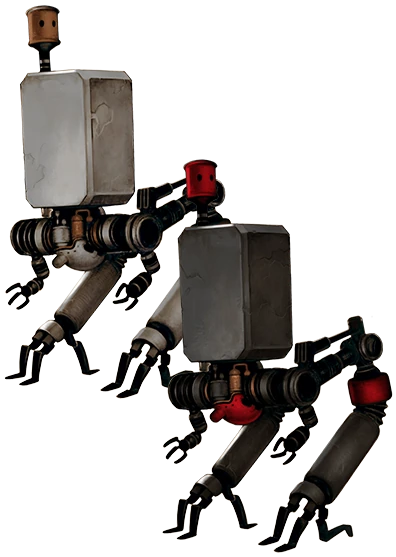
Naturally, every aspect of the YoRHa operation is steeped in extreme secrecy and paranoia. The YoRHa androids are all kept in the dark as much as possible about their mission, and special ‘E’ units are tasked with killing any individuals who discover too much. Keeping a lid on this secret seems to occupy a great deal of YoRHa resources.
One awkward loose end is operating the human base on the moon. This task is assigned to an android named 10H, and a network of Pods (small flying robots). The Pods appear to know what’s really going on, but 10H is told that she is in a deep underwater base. Her story is related in A Much Too Silent Sea in A Short Story; there is a fan translation by Merutan here on the Ark, and an official translation by Shota Okui in the Short Story Long book.
The base contains a broadcast room, which 10H is told is merely a relay. Her days are filled with menial tasks and playing games with the Pods. Time and again, she discovers she is actually on the moon, and gets killed by the Pods. Desperately, she tries to leave records for her future, post-reset self in the corners of her mind; each time, she opens the door and dies. The story relates the 46th.
It’s safe to say that YoRHa has a few problems functioning as a military organisation!
The Pearl Harbour descent: YoRHa gets traumatised for the first time

The very first story performance of anything related to NieR Automata was the YoRHa musical (音楽劇 ヨルハ). Its subject has now been represented in, well, a whole lotta ways!
Narratively, the events begin on December 8th, 11941, the 10000 year anniversary (in Japanese time) of the historical attack on Pearl Harbour, Hawaii that marked Japan’s entry into WWII. (Yoko Taro loves to insert echoes of historical dates; perhaps we should read this as drawing a parallel between the hyper-paranoid, revanchist, often fascistic YoRHa and the historical Imperial Japan? Then again, other dates appear to associate YoRHa with the allies, so maybe don’t read too much into that!)
Stage plays
The original play/musical has seen four different productions. Versions 1.0 and 1.1 predate the release of Automata. After the game’s success, they got funding for a much more elaborate version 1.2 with a new cast, and then finally the alternate all-male 1.3a. Each version of the story has small differences, for example adding or removing Resistance members. The song prominently features the two YoRHa-idol group songs Normandy and Guadalcanal, named after major battles in WWII.
The plays are really quite a spectacle—my personal favourite version is 1.2, which may be torrented here, and there is a fan subtitle linked in the comments. An English-subtitled version sometimes surfaces on Youtube, but at time of writing, none are available.
Let me give you a taste, though! Here’s the intro, Normandy:
It’s an unbelievably stylish musical, and I wish we could see an official English-subbed release one day.
Prose
The story is also related in a novelisation by Eishima Jun as YoRHa v1.05, which is printed in A Short Story; Shota Okui’s translation is in Short Story Long. Additionally, in Automata, we can read Anemone’s side of it in her in-game novellas: Encounter, Understanding, and Separation.
Manga
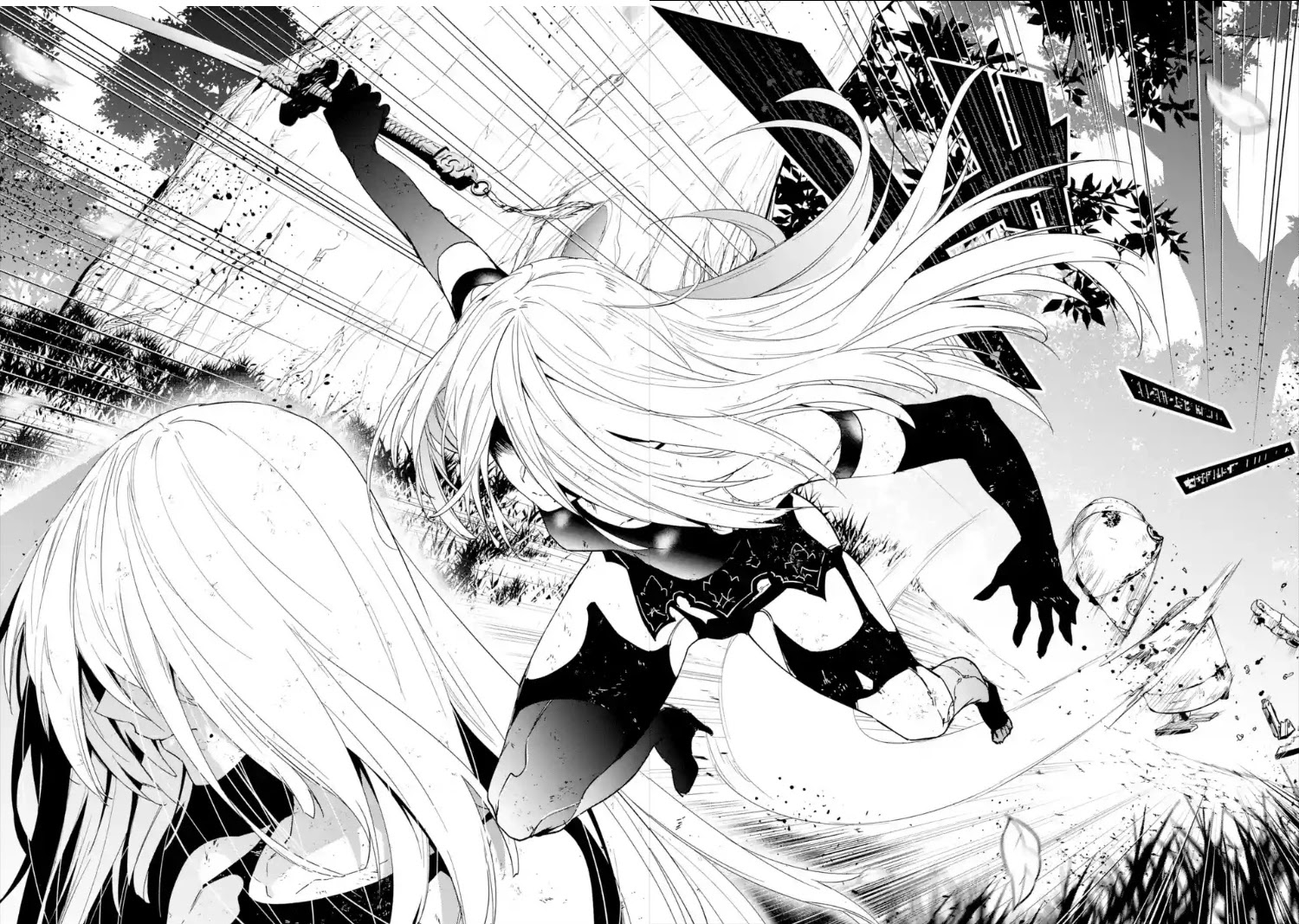
Recently the 1.2 version of the play has started being adapted into manga by Megumu Soramichi, titled YoRHa Pearl Harbor Descent Mission Record (ヨルハ 真珠湾降下作戦記録). This can be read on various scan sites [2025 edit: unfortunately the source I linked before has gone offline, but here is the mangaupdates page, and a torrent is available here], or you could watch a fanmade video version of the first chapter with audio from the musical here.
Anime
Since I wrote the first version of this article, the events were also recounted, more briefly, in Episode 6 of the NieR Automata ver 1.1a anime.
I wrote up a description of the anime version here on Tumblr. The anime version very briefly alludes to some events not seen in the show, a backstory for Lily where she is sexually assaulted by another android and Rose intervenes to protect her. The major difference in the anime is that Lily, rather than Anemone, is the central character and sole survivor of the resistance unit.
So what happens?
Do you want the long version or the short version?
I want the long version!
The Pearl Harbour descent is the first major deployment of YoRHa models.
The YoRHa squad are tasked with infiltrating a machine server at Mt. Ka’ala, linking up with a group of non-YoRHa resistance units from a previous invasion hundreds of years earlier. Descending towards Pearl Harbour, they come under fire from the Machines, killing the squad’s trusted leader No. 1. Commander White orders a satellite strike to save them, but only four androids are able to land safely: Attacker types No. 2 (who assumes command) and No. 4, Gunner type No. 16, and Scanner type No. 21. They are rapidly swarmed by machines, but saved through the intervention of a group of android resistance fighters led by Captain Rose.
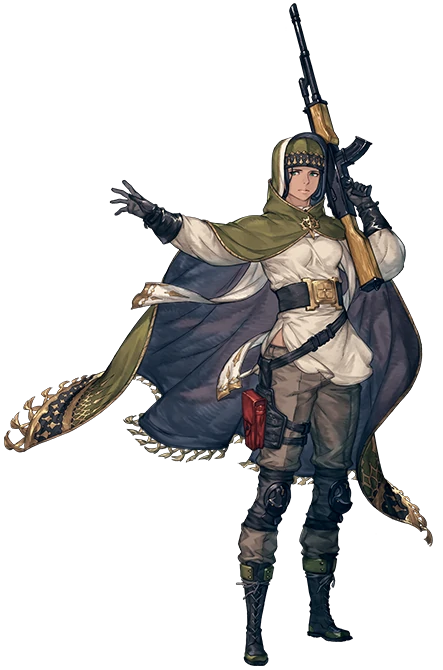
The exact list of Resistance members varies with the portrayal, but all of them except 1.3a feature one Anemone; an android who is initially distrustful but grows to accept the YoRHa after Scanner No. 21 is able to cleanse a resistance android of the Logic Virus. (In 1.3a, she is replaced with the pyromaniac Jackass, who also appears in Automata.)
Logic what?
The machines have one especially potent weapon: the Logic Virus. Under its influence—stop me if you’ve heard this one before!—the androids’ eyes grow red, and they are overwhelmed with berserk hostility, letting out all of their inner sadism. Which means… yeah, it’s the exact same symptoms as the Red Eye Disease in DoD. Whether this is because the Machine Lifeform network is actually connected to the evil God of this universe is unclear, but it certainly has a penchant for sharing imagery with the Church of the Angels (to give some foreshadowing: the Red Girls resembling Manah, the symbol of the Church later appearing on Eve, and the events of YoRHa: Dark Apocalypse all suggest a link).
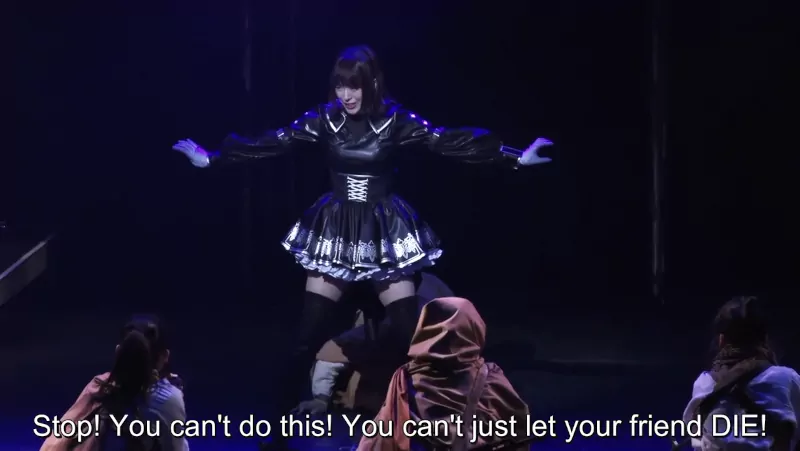
For the Resistance androids, the Logic Virus is uncurable; upon seeing signs of infection, the only remedy is to put the infected party to death. So they are naturally pretty awed by the arrival of someone who can cure it! Unfortunately, this advantage does not last, and the machines soon adapt…
A dubious fan theory
In her appearance in the game (but not so much the musical!), Attacker No. 2 has a brash, cynical personality that reminded a lot of people of Kainé. An entry in the publicity materials for the play described her false memories as living happily with her grandmother, which was taken as further evidence that A2 surely must have Kainé’s personality. I admit I’m pretty skeptical of this given how the narrative is presented in the 1.05 novel: No. 2’s recalls a peaceful existence in the countryside, while Kainé’s childhood (in her original human life, and as a Replicant) was anything but peaceful. But I feel like it’s worth mentioning, given how widely this has taken hold as received wisdom.
The mission falls apart…
White refuses to send reinforcements or order further space bombardment, much to the confusion of the YoRHa squad. At every turn, their pleas for help are met with stony refusal. In the meantime, we gradually learn more about the YoRHa squad, and the Bunker.
In the 1.0, 1.05 and 1.1 versions of the play, No. 2 remembers her companion in the Bunker, an android named Seed, who treated her with kindness and encouragement… only to die in an experiment as she began to doubt her constructed memories, with the Commander strangely unwilling to restore her from backup. Two weapons merchants, Kalmia and Clematis, also feature prominently in the earlier versions, but in 1.2 are merged into other characters like Gerbera.
In all except 1.3a, Commander White’s two Operator underlings, Futaba and Yotsuba, rankle against the callous treatment of the YoRHa. Each time, she rebukes them sternly. (In 1.3a, these are merged into a single character.)
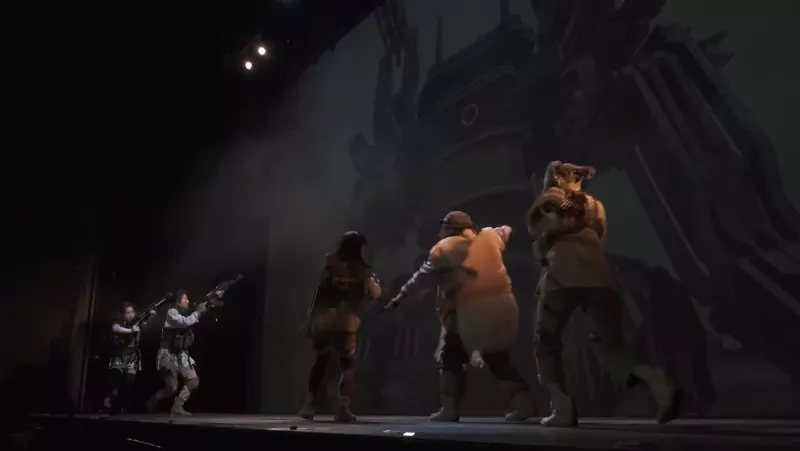
With increasing desperation, and casualties mounting, the Resistance equip themselves for a final mission. Most of the Resistance, and Gunner No. 16, stage a distraction… while the remaining small group fight to the summit of Mt. Ka’ala to find a lift that should lift will take them to the machines’ server room. At the entrance, No. 21 stays behind, realising she’s infected by the Logic Virus, and Anemone, quick to catch on, stays behind to execute her before the infection takes hold… while No. 2, No. 4 and a few survivors of the Resistance descend into the server room.
The outside group is gradually overwhelmed by the machines, unable to stop them pursuing No. 2’s group towards the mountain. As a last ditch measure, they wire their reactors together to overcharge No. 16’s weapon at the cost of their lives. In 1.2, an extra cruel twist is added: the defensive model, Daisy, survives, and sobs over the bodies of her comrades before two incarnations of N2 (the ‘Red Girls’, here named Terminals Alpha and Beta) appear and infect her with the Logic Virus.
At the top of the mountain, Anemone executes No. 21 with great difficulty, but finds herself unable to pull the trigger on herself. She resorts to descending the mountain and attempting to kill all the machines, or else achieve suicide by enemy forces.
The reveal
And the confrontation in the server room? Is ugly! Of course! The Red Girls know much more about the YoRHa mission than the girls themselves—notably that their deaths were part of the design from the start. So, too, were the extreme conditions: ultimately, the Mt. Ka’ala server is strategically irrelevant; the mission is really an experiment to place the YoRHa in a desperate situation and provoke evolution, filtering out which personalities are most useful for future models.
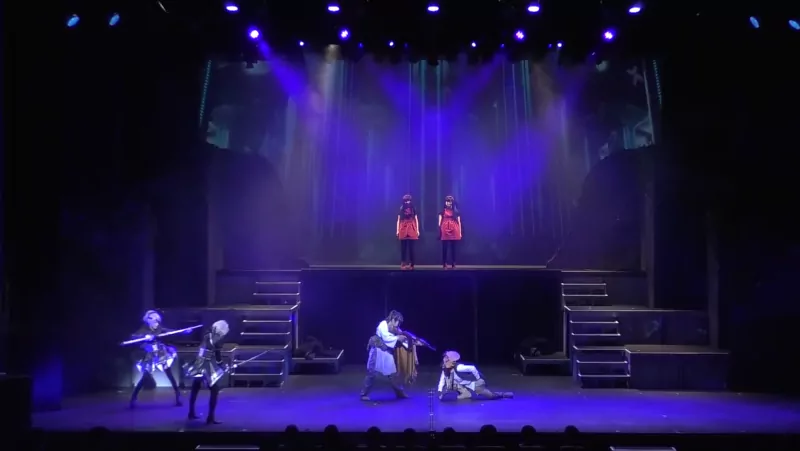
In 1.2, also—and perhaps other versions of the play—Commander White attempts, despite knowing the sacrificial nature of the plan, for intervention on behalf of the YoRHa. She is once again refused; and furthermore lectured for her insubordination in firing the satellite laser to land the YoRHa in the first place. Futaba and Yotsuba arrive, reporting the deaths of almost all the YoRHa.
N2 toys with the four (or five) survivors, killing the Resistance members and reanimating their bodies with the Logic Virus, and laughing all the while. No. 4 seems to fall, and No. 2 desperately destroys the bodies of the infected YoRHa.
N2 reveals one final little detail: each YoRHa is essentially a bomb, with their ‘black box’ fusion reactor to explode if they should die inside the server room. And sure enough, No. 4’s reactor detonates, bringing down the mountain.
But No. 2 survives. She tears out the parts of her body, like the bomb, which connect her to Command, and fights on as one woman against the Machines. Eventually she discovers that Anemone is still alive, and now leads a faction of the Resistance…
In a stinger at the end of the play, we see that Futaba and Yotsuba have had their memories reset, so they will no longer be insubordinate. Now cheerful and upbeat, she fulfils her roles in closing off the mission. Then, as the Commander leaves, we see N2 infiltrate the Bunker once again. The Red Girls delete a report of No. 2’s survival, giving her a chance to fight on… ‘Androids are so interesting, huh?’ she remarks. The musical ends with an incredibly choreographed sequence of No. 2 fighting off waves of machines.
I want the short version!
The YoRHa are an experimental group of androids deployed to test out potential personality variants. Though they are nominally going to attack a Machine Lifeform network server on Mt. Ka’ala, their mission is sacrificial: the target actually has no strategic importance. Only four YoRHa survive the descent from space; these link up with a group of Resistance members who survived from a previous descent mission, led by Rose. Refused reinforcement or support at every turn, they make a desperate attack on Mt. Ka’ala, during which almost all of the characters are killed. The Machine Lifeform network personification N2 toys with the last few survivors.

Ultimately the mountain is destroyed by the fusion bombs implanted in each of the YoRHa, one of which explodes when No. 4 is killed inside the server room. One YoRHa, Attacker No. 2 (A2), survives the explosion, and one Resistance member, Anemone, escapes to a safe distance, intending suicide by enemy forces—but ends up surviving. (In the anime, Lily is the one who survives, and Rose orders her to not commit suicide.) Betrayed and traumatised, A2 breaks off contact with Command and sets out on a one woman extermination campaign against the Machine Lifeforms; N2 permits her to live out of curiosity..
The all-male version, 1.3a/1.3aa
The first three versions of the play could plausibly be prequels to Automata, but the final production differed in a few notable ways! (This should not be confused with YoRHa Boys (少年ヨルハ)! That’s a totally different play, which we’ll get to in a minute.)
One is that this one takes place in a genderflipped universe; the YoRHa squad, Commander, etc., basically all characters in the play are now played by men. Presumably this version is just one of the many alternate universes—the same universe as ‘YoRHa Girls 1.1a’!
To quickly run down the changes: Accord (of DoD3 fame) is present, taking over the role of weapons-obsessed resistance members who appear in the other versions. This is the only ‘on screen’ appearance of Accord in the NieR world, although we find a flyer mentioning her in Automata and she is briefly mentioned in one of Yonah’s diary entries in the Replicant remake. There are a few other adjustments: the Resistance members are deserters, Anemone is replaced by Jackass, the two red girls are combined into one red boy (Terminal Omega) and the operators Futaba and Wakaba are combined into just one Wakaba. You can read more about it in detail on Rekka’s site.
1.3a can be torrented here on Nyaa, though at time of writing, there are no English subtitles available.
Equal opportunity evil experiments: the M002 unit
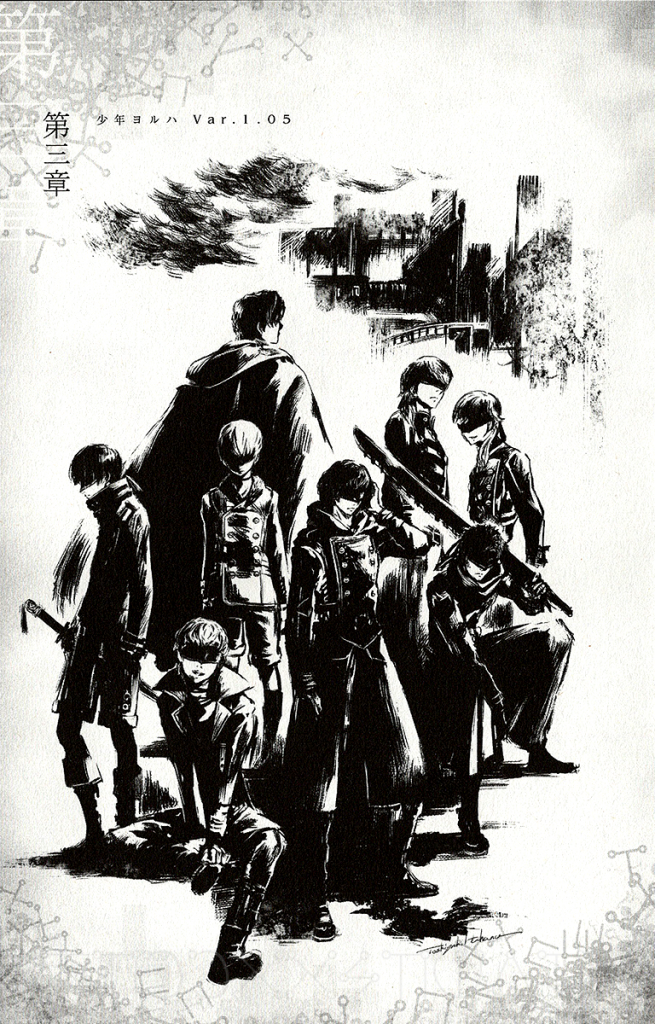
Following the ‘success’ of this first YoRHa experiment, the project continues in a similar research phase. The next major YoRHa deployment introduces the ‘M002’ unit, which experiments with ‘male’ personality models. (Of course, we could argue about what exactly gender means in this context, but for whatever historical reason, the YoRHa organisation upholds a gender division on a pretty deep level, from uniforms down to what roles androids are permitted to perform—indeed, considerably more so than the broader android forces!)
This is the subject of the stage play YoRHa Boys (少年ヨルハ). It doesn’t have quite as many versions as the original YoRHa musical, but it has a few: the original v1.0 of the play performed alongside v1.2 of YoRHa, a novelisation of this play by Eishima Jun which has been released in English, and a genderflipped version called YoRHa Girls (少女ヨルハ) v1.1a which came out a few months ago.
You can torrent the original play here, with subtitles linked in the comments.
But… what if… stay with me here, what if… what if androids were boys?
In the main, non-genderflipped continuity, the M002 unit is another experiment in YoRHa personalities and tactics, building on the results of the first squad. They’re led by an ‘instructor’, a non-YoRHa android named Black. They have have new outfits, oriented around long stylish trenchcoats, and a few technological innovations, like the ‘Supporter System’ or SS, a kind of AI-driven wristband device that is a precursor to the Pods. And there’s a new ‘H’ type android responsible for collecting backups of memories and data… which in the play is No. 9. He has, as seems to be very much the pattern, a close relationship with a Defender type, No. 2.
Compared to the first YoRHa squad, the M002 unit is deployed on many more missions, dying and resurrecting over and over—and knowing that the versions of themselves that exist beyond the backup will not be brought back.
In the play, we join them in Madagascar…
I want the long version!
The play sees them on what will become their final mission. As with YoRHa musical, the YoRHa characters link up with a small band of resistance survivors, this time led by one Captain Cactus who is despondent after having led his troops into a enemy trap. The resistance have been drawn to a distress signal left by a mysterious box; the YoRHa arrive, all gung-ho, saving them from a machine ambush, only to learn that the area is covered by heavy artillery primed to destroy anything that draws attention.
The box, it turns out, contains No. 2, much to the surprise of everyone but Instructor Black. Over the next few scenes, we are gradually introduced to the various members of the YoRHa boys squadron: the rivalry between No. 3 and No. 4 (4 became a Gunner, despite being the stronger Attacker, which 3 interpreted as an act of pity), the sadism and horniness of No. 6 (who gets off on a logic virus check performed by the Instructor through the SS wristband). And we learn of the close relationship of twin models Scanner No. 21 and Attacker No. 22 (a flashback scene shows their previous incarnations dying together on an underwater mission, No. 21 unable to protect his twin).
The main action comes when the M unit, along with the resistance members, hatch a plan to escape on an old cargo plane left untouched by the machines (who for some reason like to leave materiel untouched if it’s not in the hands of androids). They manage to board the aircraft… but No. 21 leads a mutiny against the instructors with No. 6, after intercepting messages revealing their repeated deaths are all part of the plan—and that No. 2 is under orders to exterminate the M unit entirely. He diverts the aircraft, hoping to desert in a ‘trade city’ in the Kingdom of Night.
But the mutiny only results in the plane crashing somewhere deep in a forest, and it emerges 21 has been infected with the Logic Virus. Scattered by the crash, the androids square off against each other.

No. 21 (Murata Hisashi) gives in further to the Logic Virus.
No. 6 gives in to his sadistic tendencies, and starts tormenting the Resistance members, but Cactus manages to save them by elaborately staging a suicide. 3 and 4 fight a duel. No. 4 refuses to infect 3 with the logic virus, hoping to prove himself stronger at last.
In the aftermath of Cactus’s escape, No. 6 confronts the Instructor, successfully - but the Instructor manages to activate a modified version of the scan, causing him to lose control of his body. Meanwhile, No. 2, slowly dying of the Virus, confesses his jealousy to No. 9—who has a straightforward purpose as a healer, rather than an assassin of his own side.

In the end, the survivors are No. 4, No. 9, No. 22, Cactus and the two other members of the Resistance. No. 9 attempts to fulfil 2’s final request, but it is denied… and a final voiceover from Commander White explains that the M unit performed largely as expected, but is deemed too uncooperative to be used for combat roles. For this reason, “male” YoRHa will henceforth only be scanners… creating the situation we see in the game. Meanwhile, the Gunner and Attacker roles will be merged into a new Battler role, superseding all these Attackers and Gunners. The final scene shows No. 9 sobbing as he listens to a posthumous message from No. 2 asking him to delete his data… something he cannot do.
I want the short version!
The M unit link up with a small unit of resistance, and attempt to flee on a stolen aircraft. However, several become infected with the Logic Virus, and under its influence attempt to stage a mutiny and defect. The aircraft crashes and the M unit largely kill each other, acting out their various tensions and traumas. In the end, only three survive. Disappointed with their ability to cooperate, Commander White orders that the new Battler type units will be designated “female” only, and future “male” YoRHa will only be scanners.
The all-female version, Shōjo YoRHa v1.1a

Over in the ‘a’ genderflipped version of the story, the broad events are the same, but there are a fair few changes in the details. Rather than a forest in Madagascar, the play takes place in the ruins of Shinjuku where it all began. There’s an extended ad-libbed character scene in the middle of the play, and the uniforms are much more like sailor fuku, rather than the trenchcoats worn by the boys, or the the gothic lolita dresses worn by android girls in the main timeline. The Resistance members on the other hand wear some rather flashy white coats, and are explicitly deserters. The SS in this version is more like a smartphone, and has the male voice of Pod 042 instead of the female voice of Pod 153.
For this version—the last YoRHa performance!—the staging was the most elaborate yet with a big descending screen and orb-shaped machine lifeform props being carried in a snaking pattern. For more, see Rekka.
The first act of the play is officially uploaded on Youtube with an official English sub:
The rest is torrentable on Nyaa.
The play ends, at first glance, in largely the same way. No. 2E is slowly dying of the Logic Virus, and kills herself before she goes berserk. ‘Female’ models are deemed more ‘mutually cooperative’ but also prone to questioning and mutiny, so they’ll be ‘reformatted’ and made scanners as the new Battler type comes online. A similar voiceover from No. 2 comes asking No. 9 to delete her data, which she cannot do, crying in No. 22’s arms as the sun rises. But after that, just before the credits dance, there is an additional flashback scene showing the YoRHa during a day off in the bunker, acting like playful schoolkids. No. 2 sees orders on her SS and runs off the stage with a look of horror.
Atlantis: The Lost WWII Allusion
So what happens next? This is addressed by a brief note in the timeline for 11942.
The non-Logic Virus infected squad members are presumably picked up and have their personality data recycled into future units. But No. 21 at least survives, still infected with the Logic Virus, and appears on a giant Machine Lifeform floating city called ‘Atlantis’ on June 5. Later that year, in August 7, YoRHa Type E units and 10,900 android marines attack the floating city, ultimately killing the remnants of the M unit.
I figured those dates were probably important, and sure enough, June 5 1944 saw mass Allied bombing of Normandy ahead of the D-Day landings, while August 7 1945 was the start of the Battle of Guadalcanal when America began its offensive against Imperial Japan. This seems significant given the two YoRHa idol group songs Normandy and Guadalcanal which featured in the play, though the lyrics don’t really make specific mention of particular events. As for the 10,900 marines, not sure what that’s about!
Introducing our heroes
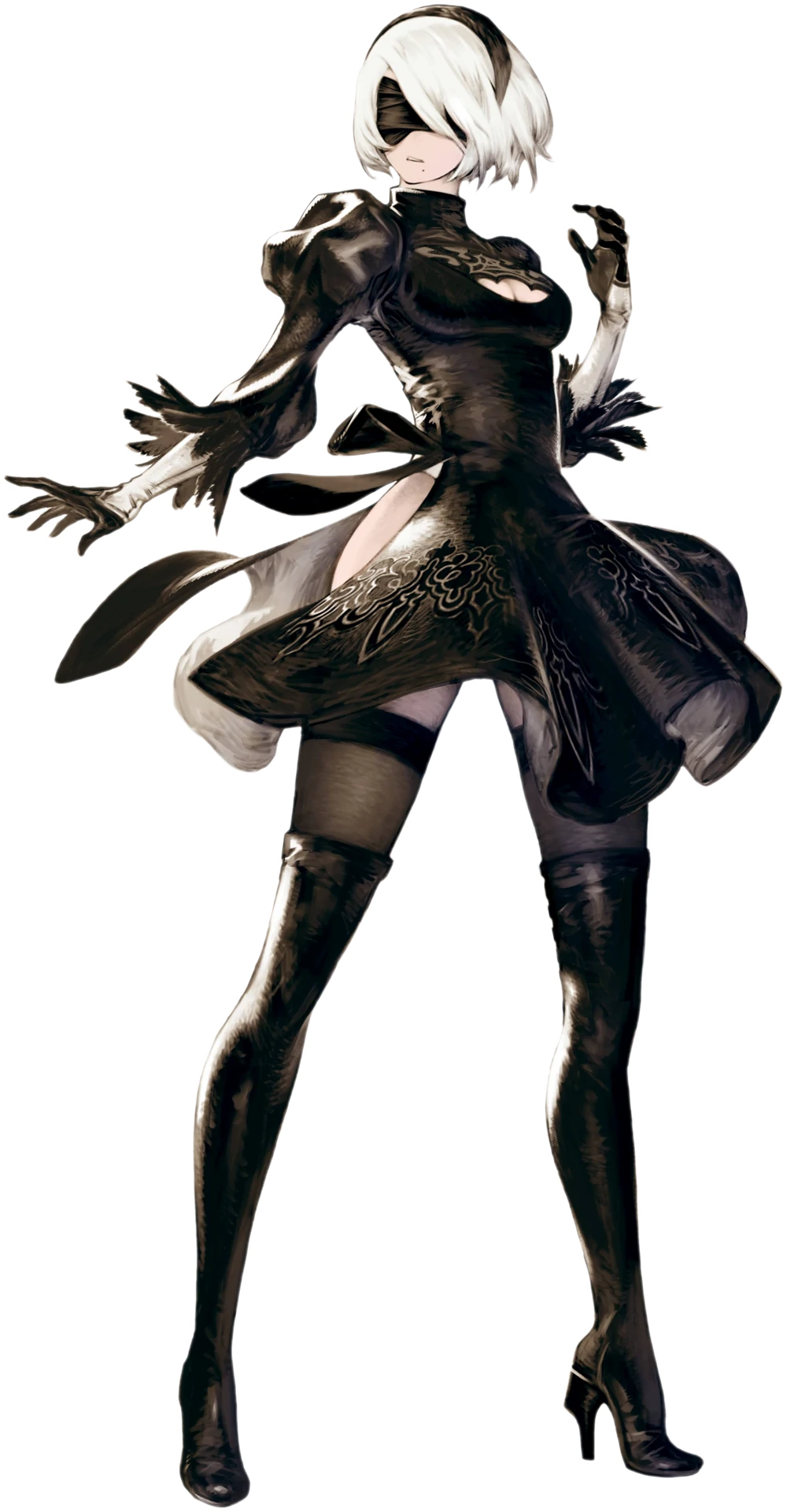
NieR Automata centres on three characters: No. 2 type B[attler], No. 9 type S[canner], and No. 2 type A[ttacker]; 2B, 9S and A2. We met A2 in the YoRHa play, but what about 2B and 9S?
So their dynamic is like this. 9S is a Scanner type, designed to gather information on the machines. 2B is his taciturn, dutiful companion unit… but she is secretly 2E, an Executioner type designed to execute 9S if he pokes his nose where he’s not supposed to. This happens very often, and each time, a new 9S is instantiated as, essentially, a factory reset. 2B, however, does not get her memories reset.
A2, meanwhile, is now living as a rogue unit; she’s reconnected with Anemone, but largely spends her time fighting the machines as a one-woman army. By this point, her uniform and much of her skin have eroded away, and she’s a lot more aggressive and cynical than when we saw her in the play.
“Everything that lives is designed to end”
The very first sortie with the pair comes in Memory Cage [Ark translation] from A Short Story. 2B and 9S investigate a mysterious desert building that is very likely the Desert Temple near Façade. 2B attempts to set an ambush to kill 9S quickly with a minimum of pain, but 9S stages a counter-ambush, surprising 2B with the ability to use a short-range weapon. He hacks her brain, and learns the truth about 2B… but also that 2B and the Commander anticipated this, and set a virus trap to destroy him when he tried to hack in. Here we see the beginning of 2B’s mantra: ‘emotions are prohibited’. Apparently they can’t be designed out…
As her pod does its job, she thinks to herself. She knows she’ll have to do this again, so she’s decided she’ll forbid herself from becoming too close to anyone else. She’ll keep the time she spends with people, the conversations she has with them, to a minimum. That way, she won’t create unnecessary memories again. That way … she won’t have emotions that should never have existed in the first place.
“We are perpetually trapped in a never-ending cycle of life and death.”
Not surprisingly, 2B completely fails to stay distant from 9S in his subsequent incarnations. Many more executions follow in the concert drama A Repeating Prayer, depicting 2B killing 9S again and again and again, getting ever more traumatised each cycle: each time, getting to know him, building a rapport, having the secrets of the Bunker and her true identity discovered, and executing him, or seeing him kill himself to spare her the trouble. You can read it here on the Ark.
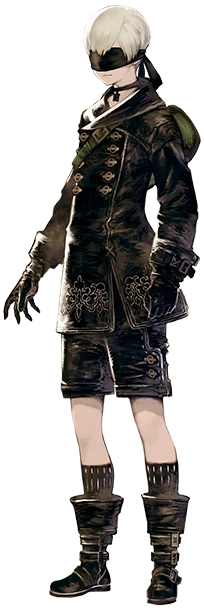
“Is this a curse? Or some kind of punishment?”
The sequel to Memory Cage is another story called Memory Thorn [Ark translation]. This time, they’re in a building once surrounded by water, containing a large tree. It is presumably the Lost Shrine, the entrance to the Shadowlord’s castle.
This time, 2B becomes infected with the Logic Virus, and 9S dives in to attempt to save her. This time, he knows full well her identity as an assassin, and has carried on anyway. He discovers her memories of killing him in the Desert Temple, and grief at killing him over and over. This time, 2B cannot bring herself to kill him, and passes him her sword so that he can kill her instead—but he chooses to kill himself, telling her that he enjoyed their time together, and not to hesitate to kill him again, because that way, some version of him will still get to see her, again and again.
“I often think about the God who blessed us with this cryptic puzzle…”
The concert drama Beasts of Slaughter introduces the third side of the triangle. 2B and 9S, it turns out, have frequently been dispatched to kill the rogue A2, now fighting for herself independent of Command. The more times they attack her, the more she learns of their strategies; 9S on the other hand, thanks to his constant personality resets, cannot evolve in the same way.
Their final meeting takes place during Automata, so we’ll come back to that later!
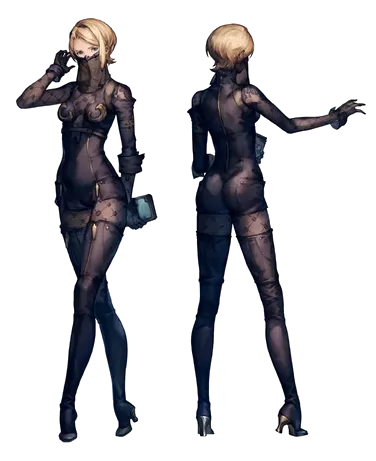
“…and wonder if I’ll ever get the chance to kill him.”
The story Orbital Bunker Observation Diary [Ark], from the World Guide, gives brief glimpses into the everyday life of various characters on the Bunker… as seen by some mysterious, strangely childish observers. These are of course the personas of the Machine Lifeform network: the Red Girls, N2, taking advantage of the back door placed by the original prototype No. 9.
The observers witness conversations between all the main characters, sketching out their relationships: the grimly dutiful Commander White, the bubbly Operator 6O, the all-business 21O caring for her charge 9S, the androids working on new flight units. 9S almost notices their presence.
There’s one cute moment where all the Operators present Valentines’ Day gifts to White:
“Today is February 14th! That date is also known as Valentine’s Day, which is a day where you give brown objects to those you adore!”
Per the timeline, this intrusion likely began on February 10th, 11945. Though there are likely to have been previous intrusions…
Meanwhile, among the Machines…
The story Small Flowers [Ark] portrays a Machine Lifeform who becomes obsessed with growing and observing a plant, even after being almost destroyed in a large-scale battle with Machine Lifeforms. We meet many other machines with a particular obsession: fighting, speed, philosophical considerations that lead them to suicide… but some machines definitely have more influence. Generally speaking, they are the bosses of the game. Many of them have become active only recently…
Plato 1728
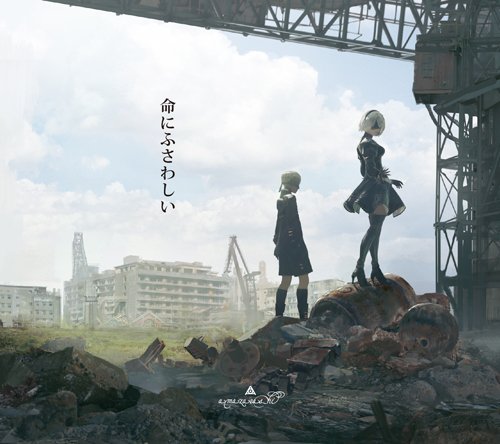
Plato 1728 is the subject of the 3C3C1D119440927 DLC for Automata and the tie-in Amazarashi single Deserving of Life. (The name of this DLC breaks down as “3 Costumes, 3 Coliseums, 1 Dream” and the date 27th September 11944, which is when these events take place in the timeline.)
You can get a sense of Plato’s story in the Machine Spear weapon story:
My name is Plato 1728. I am a failure of a machine. I was designed for combat, but I can’t use weapons. Everyone makes fun of me, and my life is horrible.
I am a dumb machine. I got lost during battle, and ended up in some kind of factory. I found a whole pile of dolls discarded there. They share the same fate I do.
I am a foolish machine. Today, I had to fight at that factory. All of the dolls got completely destroyed. Crushed by my friends and foes, who can do nothing but fight fight fight.
I activated my cannon and shot everyone there. I’m not sure why I did that. All I know is I decided to fight. Because I’m just a stupid, broken machine.
In the DLC, the player gets to relive some of Plato’s memories. He is bullied by the other machines, his broken body totally unable to pass aggressively rigged motor function and combat tests. You also get to see a bit of the ‘behind the scenes’ life of the Machines: it’s kind of a grim office environment with all sorts of petty power abuses and machines overworking themselves at various consoles. (If you want some samples, check The Dark Id’s lets play.) The machines seem to be working on a kind of giant triangular structure with a sphere at the centre, resembling Amazarashi’s logo, as well as ‘Goliath’ Engels units (more on Engels shortly!). Plato forlornly tries his best, but receives little comfort from the other machines as he fails again and again.
Offscreen, Plato becomes obsessed with some discarded dolls in a factory area, only to go berserk when these dolls are destroyed in the fighting against the androids. A more fleshed out version of Plato’s story comes in a booklet accompanying Deserving of Life, translated here by Rekka. Somehow, Plato absorbed a huge number of machines and caused a massive disaster.
The battle with Plato is most likely the subject of this timeline entry in 11944:
August 1st: The “215th Descent Operation” is carried out by a YoRHa squad. During this engagement, special machine lifeform types who take in the bodies of their allies are observed.
Finally, in the DLC, we cut to the aftermath of Plato’s rampage. Horrified by whatever happened, the surviving machines establish a policy of destroying every doll they see, lest another Plato incident come about. This is shown in the music video for Deserving of Life, which portrays a Machine Lifeform destroying dolls…
Plato, meanwhile is preserved in the Machine network, from within which he manages to contact one of the player character androids to investigate and discover his memories in a room in the amusement park with a huge stack of TVs.
All I can say is, o7 godspeed you wonderful little weirdo…
Engels
So, that big unit called Engels I mentioned. There are two parts here: a giant crane with a saw arm called Marx seems to be able to act independently; Engels himself is a vast, oil-rig like walking machine with two Marx arms and a suite of missiles named Engels. Engels seems to have been completed in 11944 since we see him in Plato’s memories; you get a record of his creation showing four being made in total, at least in that batch. More Engels units seem to have been discovered later. Engels seems to be something of a contemplative sort, at least after his defeat, but let’s come back to that…
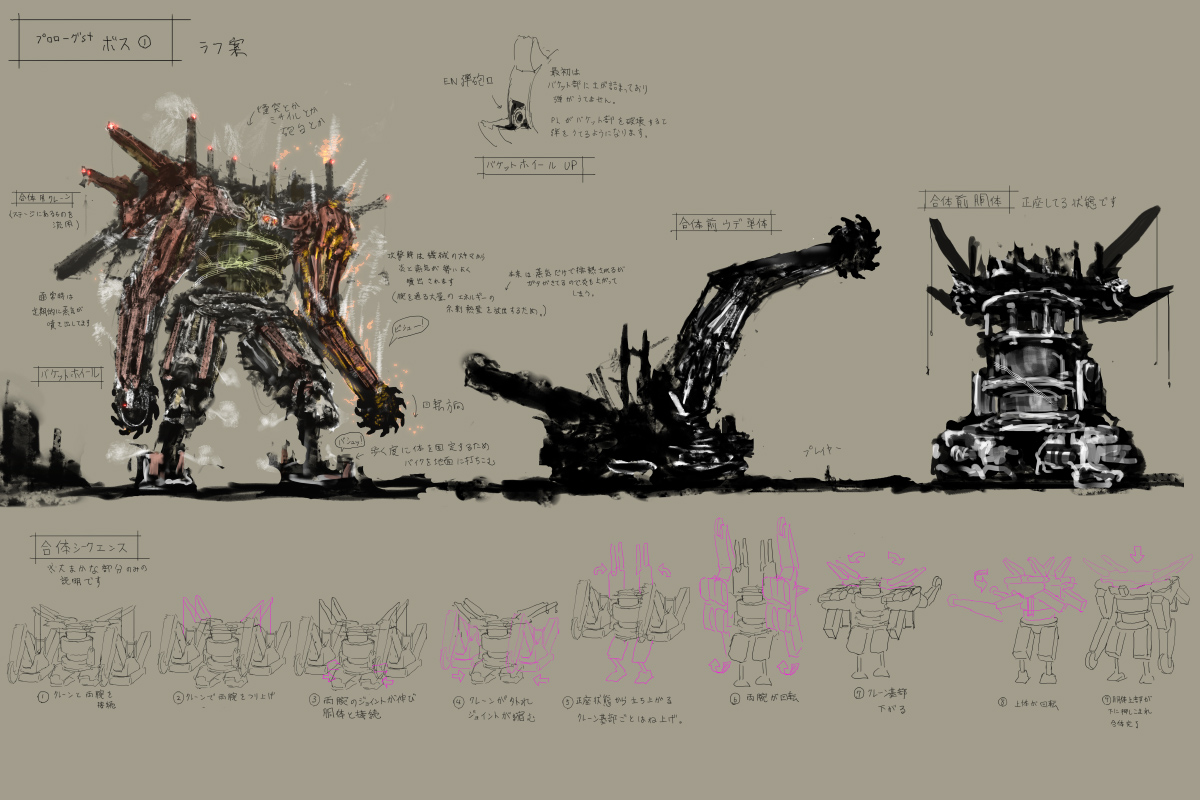
These four Engels units first appear in August 3rd 11943, and prove quite effective, killing 11,345 androids in an attack in the Phillipines. Is this a WWII thing? Doesn’t seem to be: the US was defeated by Japan in the Phillipines in 1941-42, but there’s no significance to August 3rd that I can find.
Engels is of course named after Friedrich Engels, and Marx after Karl Marx. He is able to be carried by flying machine units, since he’s pretty slow moving under his own power.
Pascal and the pacifist village

Pascal is the leader of a group of pacifist machine lifeforms, with individual minds disconnected from the Machine network. He manages to establish peaceful relations and trade with resistance leader Anemone. The machines in this village act out various versions of what they perceive as human life, adopting the roles of nuclear family members—parents and children—in a huge variety of shapes. It’s not clear exactly when Pascal broke from the Network, or make peace with Anemone, but it’s evidently gone on for some time.
Pascal is named after Blaise Pascal, though his story has less to do with the real Pascal’s theological and epistemological concerns so much as parental grief. At one point in the game, he’s seen reading a passage from Nietzsche, which he quickly dismisses.
Simone

In the Amusement Park area, there is a breakway group of pacifist clown-like machines, but one of them is distinctly not pacifist: the large machine lifeform Simone, who became infatuated (like many others) with the arrogant machine Jean-Paul in Pascal’s village. (In the Japanese release and others, they are directly named ‘de Beauvoir’ and ‘Sartre’ in keeping with the overall naming convention, but the English release changed their names to avoid upsetting the estates of those people afaiu.)
The story Memories of a Songstress, revealed during route B of the game, gives her side of the infatuation. Simone attempts to become ‘beautiful’ to catch the eye of Jean-Paul, transforming herself into the shape of a giant dress-wearing woman and decorating herself with dead androids. This is not successful, and when the player finds her, she is pretty much mad with grief and loneliness.
(In reality, the existentialist philosphers Jean-Paul Sartre and Simone de Beauvoir had a polyamorous relationship, with jealousy going the other way.)
Kierkegaard and the ‘Religious Order of Divinity through Death’
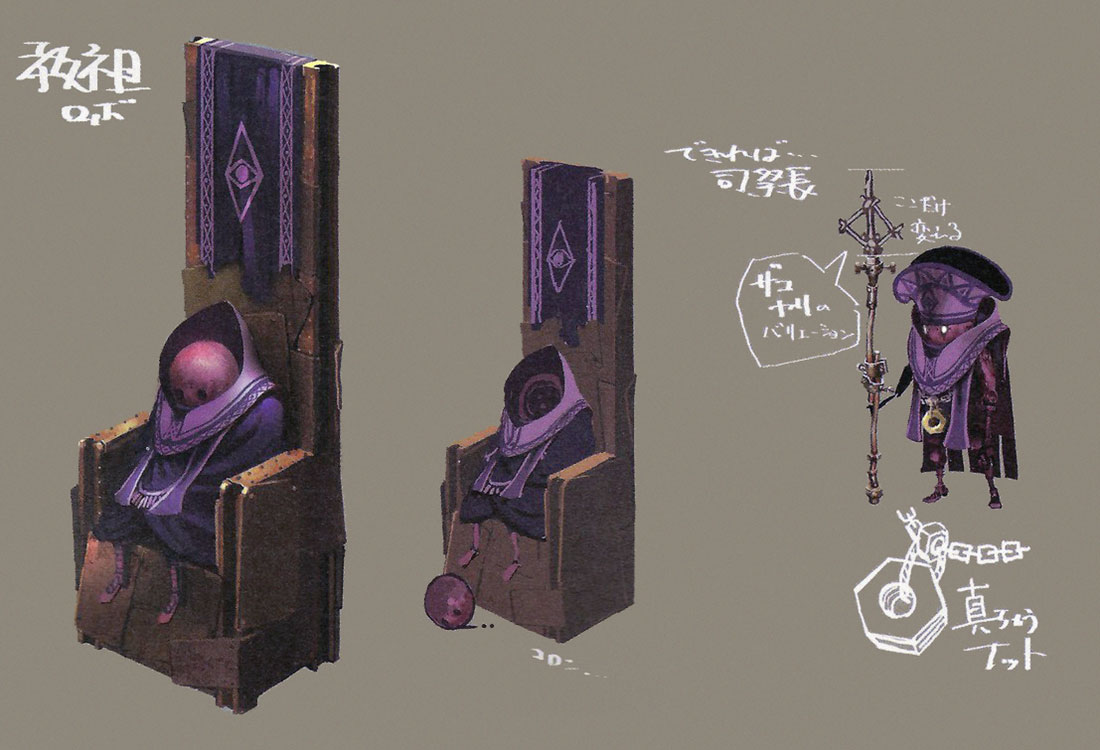
A group of machine lifeforms dressing in pseudo-Catholic robes form a death cult inside the Abandoned Factory. Exactly when this takes place is unclear—there’s no sign of them in the early game, but they seem rather well established later. The player can find some of their propaganda. They seem to be getting along well enough, but they’re getting ready for a mass ritual suicide…
Kierkegaard is named after early existentialist philosopher Søren Kierkegaard. Kierkegaard in reality died of tuberculosis. He wrote on Cato’s suicide in relation to forgiveness but did not especially seem to advocate it!
Hegel
Hegel is, by the time of Automata a colony of flying, multi-legged orbs lying inactive in the desert area. Similar machines are seen throughout the YoRHa stage plays. There’s basically no further information on him.
Hegel is named after Georg Wilhelm Friedrich Hegel, whose work (best known for his framework of ‘dialectics’) proved incredibly influential in 19th-century philosophy and onwards.
So-shi, Boku-shi, Ko-shi, and Ro-shi
These four machines share extremely similar bauplans as ball-shaped multi-legged models which can climb walls, equipped with some combination of blades and missiles. They’re sized similarly to the individual nodules of Hegel. The other thing they have in common is being named after Chinese philosophers:
- So-Shi
- 荘子, Zhuang Zhou or Zhuangzi
- Boku-Shi
- 墨子, Mozi
- Ko-Shi
- 孔子, Confucius
- Ro-shi
- 老子, Laozi
None of these machines speak to the player, or really reveal much of their subjectivity, so there is little sign of when they were built or what their motivations are, beyond that they seem closely allied with N2. The battle with Ko-Shi and Ro-Shi sees them combine into a linked machine, perhaps reflecting how Taoism and Confucianism mutually supported each other in Chinese history, or perhaps it’s just cool when robots combine with each other.
Adam and Eve
Do not exist yet… but they’ve been in the works for some time!
Our Devolapopola
A Devola and Popola pair show up in Automata—the ones whose memories we saw earlier. So what of the present?
At some point, most of the Devola and Popola models are rounded up and killed, but this pair made their way to Anemone’s resistance camp. They still seem to be viewed with a little suspicion, but accepted for their skill as medics and technicians.
As Pod 153 described, they have no memory of overseeing the Gestalt system anymore, and they’re wracked with guilt for a long-forgotten crime, kept alive merely as ‘lab rats’:
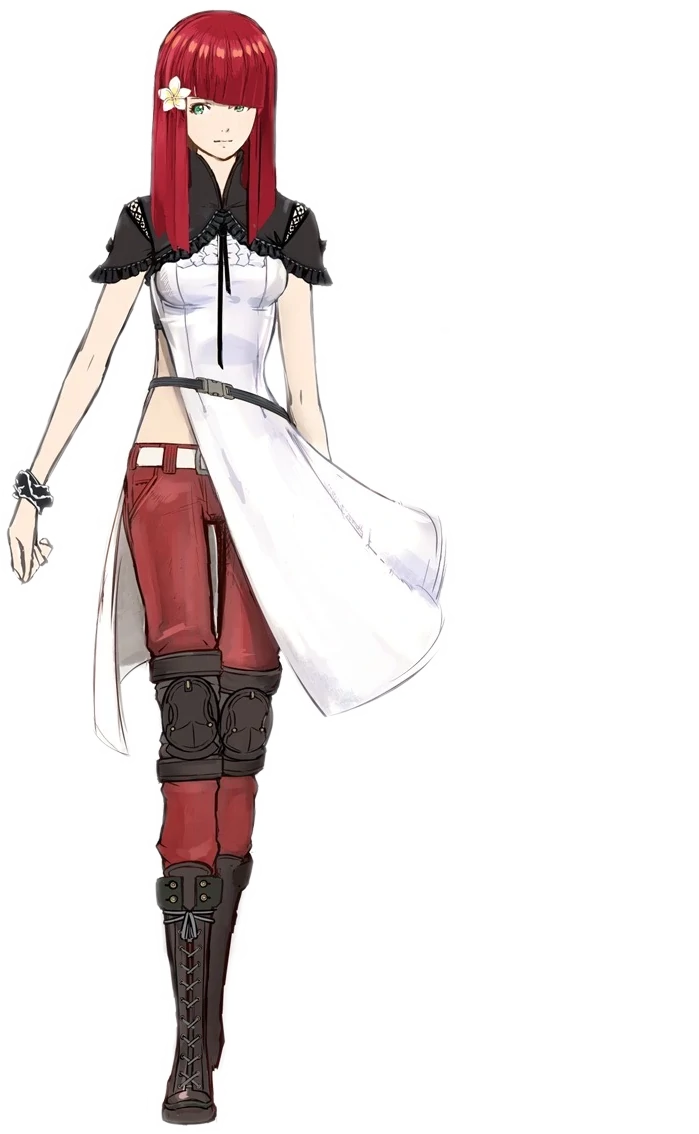
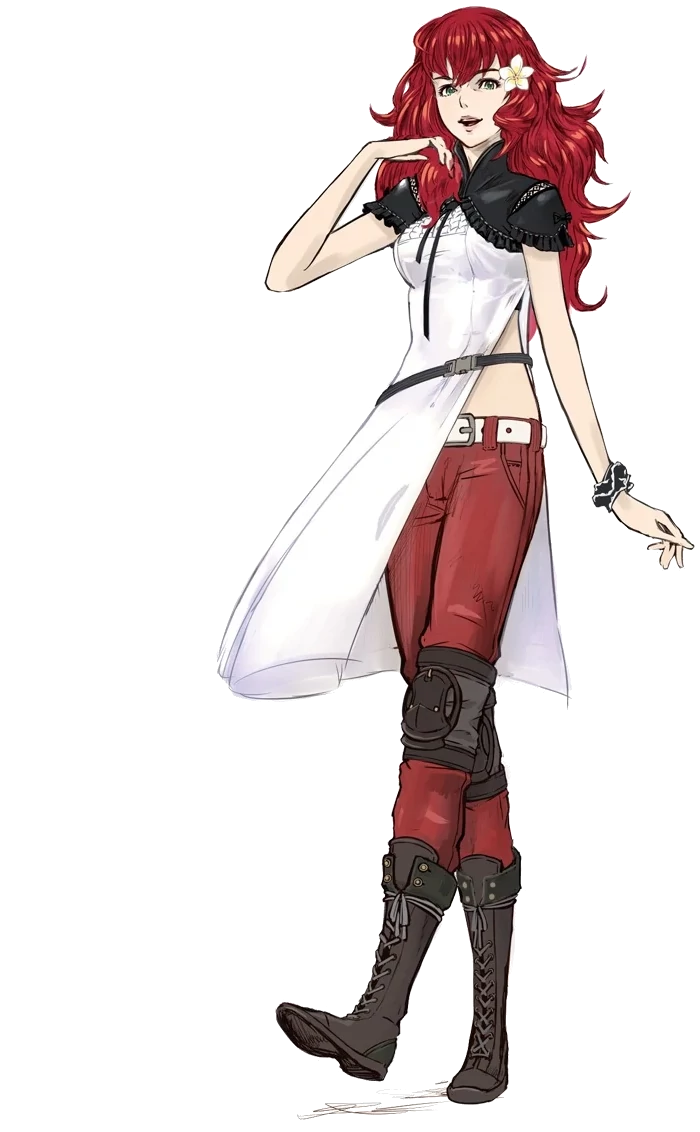
Devola: Apparently we were put here to oversee some kind of large-scale system that was put in place.
9S: Apparently? What does that mean?
Devola: We don’t know. All the records from that era have been deleted.
Our model kinda went nutso at some point in the past. It ended badly.Popola: Most of our kind were disposed of after that.
But we were spared.
They used us as a sort of control group in order to ensure such a thing couldn’t happen again.Devola: So yeah, we’re lab rats. But at least we get to be here helping out friends.
I like to think we’re atoning in some way for our past sins.
The 243rd Descent Operation
The attack of the four Engels units urgently an answer. This comes in the form of new Flight Units, essentially mecha operated by a single YoRHa. NieR Automata begins in media res, with 2B, 9S and a squad of other androids descending towards Earth, hoping to destroy Engels. None of them are prepared for how weird things are about to get in the next few months: an escalating series of events that blows the whole YoRHa conspiracy wide open, destroys the Bunker, and brings an end to the Machine War altogether, at the cost of all kinds of suffering for our three protagonists and many others.
Ready for another Yoko Taro trauma spiral? Let’s join them next time in NieR: Automata!
Comments
fherrum
Hey where’s the next part??? I want more info of what happens in the game. You explain so much stuff so well!
kc
i so hope you continue this!! you have such a great ability to convey the nuanced parts in the story while making sure to include sourced references (whether within the series itself or otherwise) and explain a thorough, understandable map of the overarching storyline… major props to you honestly, you’ve helped me comprehend the series where not much else has helped and i’ve had a lot of fun hah take care! please think about revisiting this eventually ^^
Z
4 years later and a final update would be great, the most concise and detailed telling of events for the story line I’ve ever found.
canmom (742623938c762ec774109eebb1c42915)
Hey Z! You’re in luck in fact. I’m working on the next part of the series presently, as part of a general effort to get stuff moving here again. Hopefully won’t be too long until finish it.